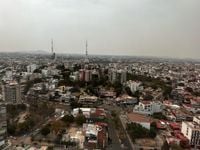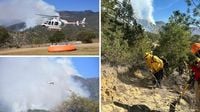On the evening of Tuesday, April 15, 2025, residents of Puebla were greeted by an unusual and intense orange sky, a phenomenon attributed to suspended particles resulting from nearby forest fires. The National Forestry Commission (Conafor) and Civil Protection of Tlaxcala reported that at least 49 brigades are currently combating fires in the regions of Altzayanca and Cuahuixmatlac, generating thick clouds of smoke that contributed to the striking visual effect.
This optical illusion, where the sun casts a reddish and orange hue across the sky, occurs when light passes through more atmosphere at sunset. Specialists from the National Meteorological Service explained that the particles filter out shorter wavelengths of light, such as blue, making the colors of the sunset appear more vibrant.
While Civil Protection has not issued air quality restrictions, they advise individuals, particularly those with respiratory conditions, to avoid outdoor activities. Similar occurrences have been documented in previous years, notably in April 2020 and May 2024, although the current presence of active fires has intensified the effect.
Social media users shared images of the striking sky, expressing concern over the visible smoke. Authorities from both Puebla and Tlaxcala are maintaining joint surveillance and urging residents to refrain from lighting bonfires or conducting agricultural burns. Citizens are encouraged to report any fires to the hotline 800-4623-634. Monitoring efforts will continue in the coming hours, as the situation remains dynamic.
As of April 13, 2025, the situation in Puebla has become increasingly critical, with seven active fires reported in the state, four of which are located in Natural Protected Areas (ANP). Laura Velázquez Alzúa, the National Coordinator of Civil Protection, highlighted that there are currently 114 forest fires across 23 entities in the country, with Puebla ranking eighth for the highest number of incidents.
A total of 3,978 personnel are involved in firefighting efforts, including members from Conafor, the Secretary of National Defense (Sedena), the National Guard, the Secretary of the Navy, as well as state and municipal governments and local volunteer organizations. Reports indicate that in 46 of the 114 active fires, control measures have advanced between 80 to 100 percent, while efforts continue in the remaining 68.
One significant fire continues to rage in the area of Libres, which has been devastating green spaces since April 13. The State Fire Management Center reported that as of 8:30 AM on April 15, the fire on Toluca Hill in the municipality of Libres remains active. Brigades 3 and 5 from the 'Coyotes' group, along with the National Forestry Commission and local Civil Protection services, are working tirelessly to mitigate the flames. They are conducting aerial assessments and water drops to extinguish the fire.
The fire in Libres has been complicated by ongoing drought conditions, which have exacerbated the situation. The National Coordinator of Civil Protection, Laura Velázquez, reported during a morning briefing on April 14 that this fire is just one of seven active blazes consuming natural areas across Puebla.
In a worrying update, Bernabé López Santos, head of Civil Protection, announced that five homes are at risk of being engulfed by the flames in Libres. The fire was reignited in the Cerro del Palmar area due to strong winds, which have complicated firefighting efforts. Currently, there are four active fires in the towns of Libres, Quecholac, Citlaltépetl, and Cerro Gordo in Tlachichuca.
To combat these fires, more than 100 personnel are working on the ground, supported by water drops from two state helicopters, each discharging between 300 to 500 liters of water. The situation in Citlaltépetl shows some progress, with 70 percent control and 60 percent containment reported.
So far this year, Puebla has seen a staggering total of 193 forest fires, affecting over 2,488 hectares of forest and grassland. The authorities are urging the public to remain vigilant and report any signs of fire, as the hot and dry conditions continue to pose a significant risk to the region.
As the situation evolves, local and national authorities are committed to monitoring and responding to these dangerous incidents, emphasizing the importance of community cooperation in preventing further outbreaks. The ongoing drought and high winds remain critical factors in the spread of these fires, leading to heightened vigilance and preparedness among firefighting teams.







